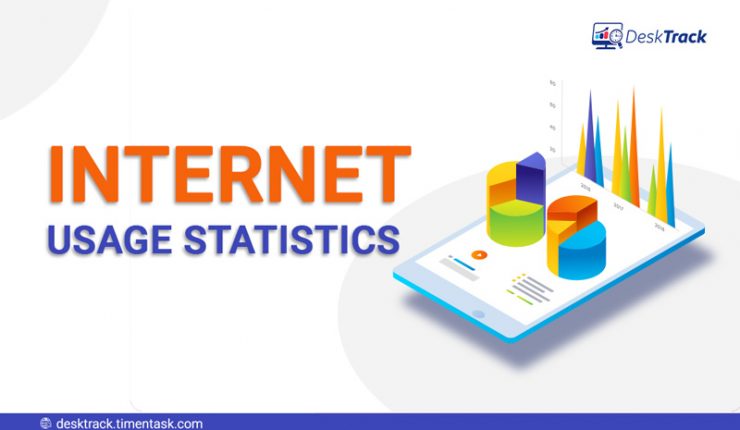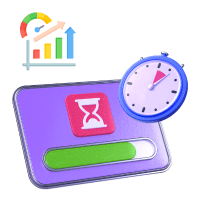
From online conversation to ordering food to completely changing one’s real life with the virtual one, the internet has become an integral part of our lives whether we like it or not. We are now taking the internet for granted. The Internet has connected businesses, people, and resources worldwide with higher efficiency and speed than any other type of contact. Overall, the internet is a fascinating phenomenon that has changed our world.
If you want to save money on office Internet Data, you should learn How to Monitor Internet Usage in Office Network to see the amount of data being wasted on unnecessary items. Let us look at the top Internet Usage Statistics of Internet Usage in the World and how it is changing the world.
Evolution of Internet Usage
In 2020, Internet Usage Statistics shown that the number of people with Internet access was around 4.83 billion, meaning that over 60% of the world’s population has access to the Internet. It is a far cry from 1995 when only 16 million people had access to Internet usage in the world. Moving further, we see that about 90% of humankind, aged 6 years, will be online by the time we reach 2030. According to cybersecurity ventures, 6 billion internet users will be in the coming year.
With everything to do online, this internet data usage monitor statistics should not be surprising. On average, the internet user spends about 7 hours online daily. Many business owners, especially eCommerce owners, want to know how internet users spend their time online. According to recent figures, more than 92% of internet users visit online stores, 80% perform online searches for the products or services to purchase, and 78% follow through with their purchase. Other than shopping, most internet users spend time on social media. An average internet user will spend over 2 hours daily on social media, with most time spent on Instagram, TikTok, and Facebook.
The development of 5G is going to change the world. This type of connection will offer a much faster communication medium. So, internet users can expect internet speeds up to a few gigabits per second, leading to higher internet data usage monitor. With this, smart devices will perform tasks faster than 4G. It will also offer a very-low latency network, with a latency of 30ms. With this, the IoT devices will get huge amplification on tasks such as surgery. The widespread of 5G determines which country uses internet the most.
Global Internet Penetration and Which Country Uses Internet The Most
1. Percentage of the Population with Internet Access
Internet usage statistics of people with internet access varies from country to region. As of January 2023, it is reported that over 5.16 billion people have access to the Internet. It is about 64.4% of the global population.
2. Regional Variations and Disparities
Regarding which country uses internet the most, there are major regional variations and disparities in internet penetration worldwide. Developed regions such as Europe and North America have higher penetration rates, generally exceeding 90% of the population. On the other hand, developing regions like Latin America, Asia, and Africa naturally have lower internet penetration rates, below 50% or lower in some cases. Many people learn how to monitor data usage on PCs to save costs by knowing how much data has been used unnecessarily.
One of the most interesting facts about world wide web is that the Gender disparities were higher in the Arab States and Africa, with a 10% difference. Worldwide regions, like CIS and Europe, showed a smaller gender gap. In 2022, internet usage statistics shown that global internet usage was high amongst individuals between the ages of 15-24 in all regions. You can take the help of the internet data usage calculator to learn more about gender disparities.
3. Factors Influencing Internet Adoption
According to internet data usage calculator, several factors affect the internet adoption rates in different countries and regions, such as:
- Infrastructure
- Socioeconomic factors
- Affordability
- Government regulations and policies
- Language and cultural barriers
- Social factors
Popular Internet Activities
1. Social Media Usage Statistics
With the rise of the internet, the use of social media has also grown significantly; the following are the statistics for social media usage:
- Facebook: 2.9 billion active users.
- YouTube: 2.5 billion users.
- WhatsApp: 2 billion active users.
- TikTok: 1 billion active users.
- QQ: 575 million active users.
- Facebook Messenger: 988 million active users.
- WeChat: 1.26 billion active users.
- Douyin: 600 million active users.
- Sina Weibo: 573 million active users.
In 2021, there were over 4.5 billion social media users across the globe. Facebook is the third most visited site in the globe. In 2021, TikTok was the most downloaded application. Another interesting facts about world wide web is that the use of Instagram is more in other countries than in the USA, as more than 80% of people use Instagram outside the US. You can learn how to monitor data usage on PC to identify the app which uses most of your data.
2. Online Shopping and E-commerce Trends
Online sales are roaring and playing a major role in retail. In 2022, Statista reported that eCommerce sales would contribute to close to 20% of worldwide sales. Forecasts show that by the end of 2026, online sales will make up for a quarter of the global retail sales. In recent years, online shopping has significantly grown in popularity. In 2021, global online sales were close to $5 trillion; this figure is expected to rise by 56% and touch $8 trillion in 2026.
3. Streaming and Video Consumption Patterns
Online video consumption has risen significantly, with the average viewer spending 17 hours a week watching online videos in 2023. According to the latest online video-watching statistics, more than 81% of internet users globally watch online videos every week. It refers to any type of video, from music to influencer videos to gaming tutorials and walkthroughs.
Internet Usage by Demographics
1. Age Groups and Their Online Behavior
According to Statista, a third of online users globally were between 25 and 34 years old. Website visitors in this age bracket tend to constitute the biggest group of users globally. Moreover, 18% of global online users were aged between 18-24 years. The global digital population aged 65 or older is represented by roughly 5.5% of all internet users across the globe.
2. Gender Differences in Internet Usage
As of 2022, the internet users share in Europe was the highest, with 89% of the female population and 90% of the male population having access to the internet. In the same year, about 83% of female and 84% of male internet users were in the CIS region, making it the second region in the world by internet usage. African region had the lowest internet access.
3. Internet Usage in Rural vs. Urban Areas
According to the latest reports, the gap between daily users in rural and urban areas was reduced in 2022, then in 2021. In 2022, approximately 93% of urban users consumed the internet daily, whereas rural areas had 86% of internet consumers. Most of the rural areas where there are offices learns how to monitor internet usage in office network so that they can limit the use of internet on professional settings. About 80% of big companies monitor the internet usage, email, and phone of their employees.
Internet Usage in Business and Education
1. Digital Transformation in Industries
Companies and enterprises worldwide recognize the current scenario and the success which can be achieved with a robust digital strategy, regardless of whether most of these companies have just started the digital transformation process. According to Gartner, more than 91% of enterprises are engaged in some type of digital initiative, and 87% of business leaders say that digitalization is the primary priority. By the time we reach 2025, three out of every four business executives can adapt to new markets and industries with the help of digital platforms.
2. E-learning and Online Education Statistics
Online learning is one of the top internet trends that have picked a pace in this digital age. Its growth is significant and is not showing any signs of stopping. The global industry has grown by 900% globally. The online learning industry will hit the whopping mark of $325 billion in 2025.
3. Impact of Remote Work and Telecommuting
Benefits of remote and hybrid working for the staff include better well-being, self-reported productivity and work satisfaction, new collaboration methods, and inclusive ways of using technology for task completion. Global Workplace Analytics report about Statistics Usage of Internet says that about 74% of employees feel happier working remotely. The same study found that 50% of surveyed employees are ready for pay just for the opportunity to work from home.
Must Visit: Work From Home Monitoring Software
Privacy and Security Concerns
1. Data Breaches and Cyber Threats
According to the latest statistics, it is estimated that 2023 will experience over 33 billion account breaches. The total amount of cyber attacks was estimated to be over 8,00,000 in total, and on average, there is a hacker attack once every 39 seconds. The Internet Usage India found that India is amongst those countries having a significant amount of cyberattacks.
2. User Attitudes Toward Privacy Protection
The statistics usage of Internet shows that users are apprehensive about privacy, as 74% said they highly value data privacy. Moreover, 83% of internet users say they understand the value of sharing data with brands under appropriate conditions.
3. Government Regulations and Initiatives
The International Data Corporation stated that AI in the cybersecurity market is growing significantly at a CAGR of 23.6% and is expected to reach a market value of $46.3 billion in 2027. Governments all around the world have launched several initiatives for creating a solid cybersecurity ecosystem in the world. For instance, the rising internet usage India has led the country to launch the Cyber Surakshit Bharat in the Ministry of Electronics and Information Technology.
Future Trends and Predictions
1. Internet of Things (IoT) Growth
Global IoT spending has increased yearly by at least $40 billion since 2018. The 2020’s IoT spending reached $749 billion. In 2022, worldwide IoT spending was predicted to reach $1 trillion. And in 2023, spending is all set to reach $1.1 trillion.
2. Virtual and Augmented Reality Advancements
The market size of VR and AR is estimated to hit $296.9 billion in 2024. From 2021 to 2028, VR’s compound yearly growth rate is 18%. About 14.94 million AR and VR headsets were shipped to customers in 2022. This decade is going to experience several other Features of the World Wide Web.
3. Predictions for Internet Usage in the Coming Years
In 2028, 5G will be the primary reason for the rise of mobile traffic, since 4G traffic is expected to fall. The average monthly usage per smartphone in the world is 19 GB in 2023 and is expected to reach 46 GB by the end of 2028.
Conclusion
These are all the essential Internet Usage Statistics and Features of the World Wide Web. Keeping up with the internet statistics is necessary for staying updated about the current technologies, developments, and best practices in your field. Internet statistics highlight every aspect of the Web’s present and past. We hope this article has provided detailed insights into those statistics and helped you make informed decisions for your business, studies, or any other reasons.








